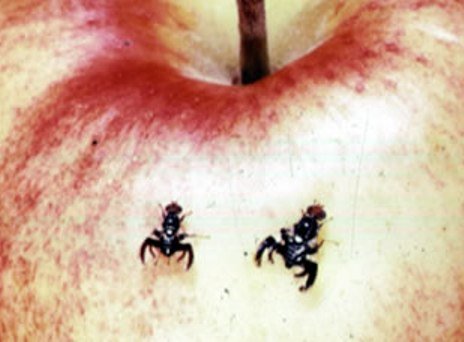|
Apple Maggot
View more pictures: Bing Images Google Images Yahoo Images Common names: Apple Maggot, Apple Fruit Fly, Railroad Worm Scientific name: Rhagoletis pomonella Region: This fly is found in eastern United States and southern Canada. Life cycle: This fly produces one to two generations each year and hibernates in the soil as brown pupae. The flies lay their eggs in the flesh of apples, usually the sweet or subacid, thin-skinned varieties that ripen during the summer or early fall, and the legless maggots develop in the flesh of the fruit. Physical Description: This 1/4 inch long fly is black with yellow legs and yellow markings across the abdomen and zigzag bands across the wings. The eggs are laid singly in small punctures made in the skin of apples. The 1/4 long larva is white or yellow. Feeding characteristics: This pest will primarily attack apples, but can also be found on blueberries, cherries, and plums. Once the larvae hatch inside the fruit, they form winding tunnels, often causing the fruit to rot. Controls: Collect dropped apples once to twice a week to reduce the population. You can feed the dropped apples to livestock, or drop in water to kill the maggots and make apple cider if the fruit is not too seriously damaged. You can trap flies before they can do damage by mixing one part blackstrap molasses or malt extract to nine parts water. You can add yeast to encourage fermentation, and pour into wide mouthed jars and hang from trees limbs. If you want to monitor the fly populations, use bait made of 2 teaspoons household ammonia and 1/4 teaspoon soap powder in a quart of water. Hang the jars about shoulder height on the sunny side of the trees throughout the orchard. A dozen jars should suffice in giving you an accurate picture of the fly activity. Examine the flytraps every two to three days to keep a count. The bait should be changed at least once a week. One of the most effective homemade traps is to hang plastic fruit covered with sticky Tanglefoot or Stickem. If this insect continues to be a large problem, the solution may be to grow tough skinned varieties, such as York, Imperial, Winesap, or Jonathan apples. Return from Apple Maggot to Insects A-D Encyclopedia of Garden Insects |
